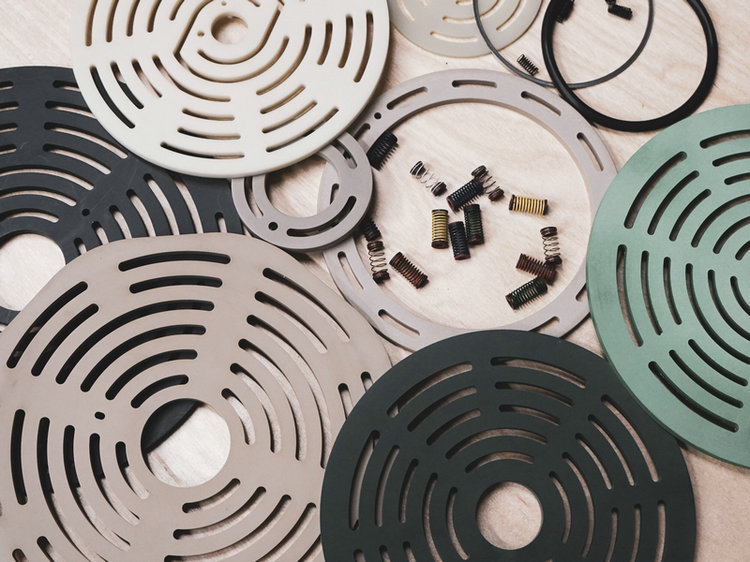
In the critical control units of subsea oilfield blowout preventers, aircraft engine fuel regulators, and artificial heart valves, a precision valve plate made from Polyetheretherketone (PEEK) is redefining reliability standards. As a pinnacle of high-performance engineering plastics, the PEEK valve plate challenges the limits of temperature, pressure, and chemical media—shattering the boundaries set by traditional metals and conventional plastics.
This article delves into the molecular science, manufacturing processes, application scenarios, and cutting-edge advancements behind this extraordinary material.
PEEK is composed of alternating benzene rings, ether bonds, and ketone groups. Its rigid molecular backbone and high crystallinity (30%~35%) result in:
Rigid aromatic structure: Exceptional mechanical strength (tensile strength >100 MPa)
Flexible ether segments: Maintains impact resistance at -60°C (retention rate >80%)
Stable ketone groups: Outstanding chemical and thermal resistance (Tg 143°C, melting point 343°C)
| Performance | PEEK | Metal/Plastic Reference |
| Continuous Use Temperature | 260°C (Short-term: 316°C) | Stainless Steel: 600°C / PTFE: 260°C |
| Tensile Strength | 100–140 MPa | Aluminum Alloy: 200–500 MPa |
| Chemical Resistance | Withstands 95% H₂SO₄, 50% NaOH | 316L Steel susceptible to Cl⁻ corrosion |
| Friction Coefficient | 0.3–0.4 (dry) | PTFE: 0.05–0.1 |
| Density | 1.32 g/cm³ | Aluminum: 2.7 / Steel: 7.8 g/cm³ |
Key Benefits:
Lightweight Metal Replacement: 60% lighter than stainless steel, reducing inertia.
Corrosion-Free & Maintenance-Free: No electrochemical corrosion or coating failures.
Precision Machining: Ultra-thin (0.1mm) with tolerance ±0.01mm.
Subsea Blowout Preventer Valves: Withstands 150 MPa pressure and H₂S (1000+ ppm), 10+ years lifespan.
Case Study: Equinor’s Lofoten field reduced maintenance costs by 70% after replacing metal plates.
Shale Gas Fracturing Pumps: Resists particle erosion (<0.01 g/h) and 70 MPa pressure waves.
Laser-clad WC coatings increase hardness to HV 1200.
Aircraft Fuel Regulator Valves: Maintains ±1% flow accuracy from -55°C to 150°C.
Passes MIL-STD-810G (20–2000Hz, 50Grms vibration).
Rocket Propellant Valves: Resistant to liquid oxygen (-183°C), hydrazine corrosion, and >1000kGy gamma irradiation.
Artificial Heart Valves: ISO 10993 biocompatibility, long-term blood contact durability.
Hemodynamics-optimized to reduce turbulence and clot risk.
Sterilization Equipment: Withstands 132°C steam cycles (5000+ times) with no degradation.
Silver-ion antimicrobial coatings reduce bacteria by 99.9%.
Supercritical CO₂ Turbines: Stable near 31°C/7.38 MPa critical point, <0.1% leakage rate.
Thermal shock resistant (>100°C/s).
Semiconductor Ultrapure Water Valves: Metal ion release <0.1ppb (SEMI F57 compliant).
Handles >1 million cycles without fatigue failure.
Injection Molding:
Melt temp: 380–400°C, mold temp: 160–180°C, pressure: 120–150 MPa
Crystallinity control is key (dynamic mold temp required).
CNC Machining:
PCD diamond tools, 3000–5000 rpm, 0.05mm/rev feed
Achieves mirror-grade Ra 0.2 μm surface finish
Fiber Reinforcement:
Carbon fiber (30%): Strength up to 300 MPa, HDT 315°C
Glass fiber (30%): Cost reduction by 40% for civilian use
Nano-Composite Additives:
Graphene (2–5%): Improves thermal conductivity to 1.5 W/m·K
Silica nanoparticles (5%): Reduces friction to 0.2
Plasma Spraying: Al₂O₃-TiO₂ coating enhances oxidation resistance 5x
Ion Implantation: Nitrogen ions raise hardness to HV 400
Electroless Plating: Ni-PTFE composite layer offers wear resistance & self-lubrication
High-Temperature Creep: 0.5–1% deformation risk above 260°C
High Material Cost: ~¥600–800/kg, limiting civilian adoption
Bonding Difficulty: Low surface energy (44 mN/m), requires plasma activation
3D Printing:
Laser Sintering (SLS) enables integrated, leak-proof valve paths
Example: GE Additive’s PEEK valve plate with <0.5% porosity
Molecular Modification:
Copolymerization with biphenyl (PEEK-PEDEK) raises Tg to 160°C
Smart Composites:
Embedded carbon nanotube networks for real-time stress/crack monitoring
Temperature-Pressure Envelopes: Ensure conditions are within PEEK limits
Media Compatibility: Avoid nitric/sulfuric acid >50% and molten alkali metals
Dynamic Frequency: For >10Hz applications, use carbon-fiber reinforced grades
Preload Control: Bolt torque error <±5% (use digital torque wrenches)
Lubrication: PFPE grease reduces frictional power by 30%
Service Monitoring: Check hardness every 5000 hours; replace if it drops >10%
With its metal-replacing, high-endurance capabilities, PEEK valve plates are pushing the boundaries in energy, aerospace, and healthcare. As 3D printing and nanocomposites converge, the future holds smart, ultra-durable PEEK components capable of thriving in the harshest environments.